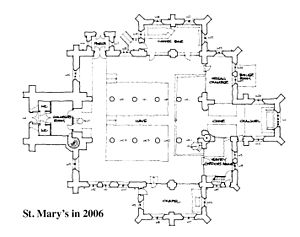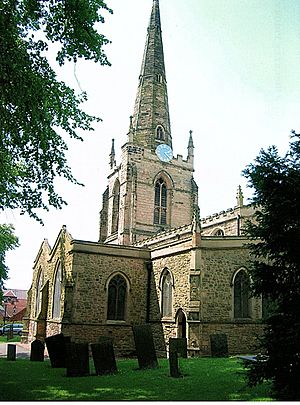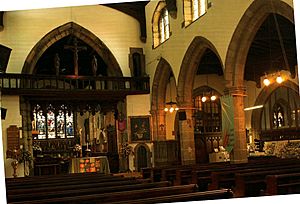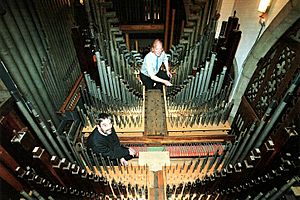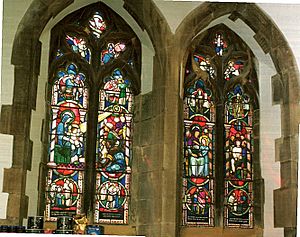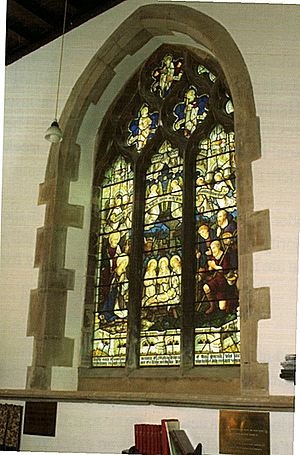St Mary's Church, Hinckley facts for kids
Quick facts for kids St Mary's Parish Church, Hinckley |
|
|---|---|

St Mary's Church, Hinckley
|
|
| Lua error in Module:Location_map at line 420: attempt to index field 'wikibase' (a nil value). | |
| Location | Hinckley, Leicestershire |
| Country | England |
| Denomination | Anglican |
| Website | [1] |
| History | |
| Status | Parish church |
| Dedication | Saint Mary |
| Architecture | |
| Functional status | Active |
| Heritage designation | Grade II* |
| Architect(s) | William FitzOsbern |
| Architectural type | Church |
| Specifications | |
| Spire height | 56m |
| Administration | |
| Parish | St Mary's Parish |
| Archdeaconry | Loughborough |
| Diocese | Leicester |
| Province | Canterbury |
St Mary's Parish Church is the oldest building in Hinckley, a town in Leicestershire, England. It's an Anglican church, meaning it belongs to the Church of England. This historic building is so important that it's officially recognized as a Grade II* listed building by Historic England. Today, you can even find a coffee bar in what used to be the North Chapel!
Contents
A Look Back: St Mary's Church History
St Mary's Church has a very long history, stretching back almost 900 years! It was dedicated to the Assumption of Saint Mary the Virgin during the Middle Ages. There might have been an even older church here, as parts of an Anglo-Saxon sun-dial can still be seen on the church's south-east corner. The church was built by William FitzOsbern, who came to England with William the Conqueror in 1066.
From Norman Times to Today
A church has stood on this spot for over 900 years. Many historians agree that a Saxon church existed in Hinckley before the current one. The name Hinckley itself is Anglo-Saxon, meaning "Hinck's meadow." If there was an Anglo-Saxon village here, it's very likely they had a church.
The church's founder, William FitzOsbern, gave its income to the Abbey of Lyre in Normandy. This connection with the French abbey continued until 1415. Then, the income was given to the Priory of Mount Grace in Yorkshire. This explains why Mount Grace High School in Hinckley is built on land once owned by the church!
When Henry VIII closed the monasteries in 1542, he gave the church's lands and the right to choose the vicar to the Dean and Chapter of Westminster Abbey. They kept this right until 1874, when it was transferred to the Bishop of Peterborough. When Leicester became its own diocese in 1926, the Bishop of Leicester took over, and still holds this right today.
A Benedictine priory was also founded in Hinckley in the 11th century. This old priory building was next to the church, where the St Mary's Church Community Hall is now. It was taken down in 1827 to build cottages, which were then removed in 1912.
The Church Building You See Today
The church building we see now was rebuilt in the 13th century. A wooden beam found during later repairs had the date 1246 carved on it. The oldest parts of the church, like the tower, nave, and chancel, date from around 1240 to 1400.
Victorian Era Changes
A huge restoration project happened between 1875 and 1878. It cost £10,000, which would be like £10,000,000 today! The architect for this work was Ewan Christian. The vicar at the time, Rev. W.H. Disney, wrote about his time in Hinckley. He mentioned how hard the work was in this busy manufacturing town. There's a special plaque in the church to remember him.
During this time, the old north and south aisles (side sections) and transepts (cross-shaped parts) were taken down. A large singing gallery, built in 1723, was also removed. This gallery used to stick out into the church. There were also galleries in the side aisles. The north gallery used to hold 360 poor people on benches.
New, larger aisles and transepts were built. Once finished, the church could seat 1,200 people on oak pews. Each transept even had its own door so children could enter and leave without disturbing others! The chancel (the area around the altar) was also repaired and given a new roof in 1880. Sadly, some of the stone used by the Victorians was not very good quality and has had to be replaced over the years.
Recent Repairs and Upgrades
A lot of repair work was done on the spire and tower in 1993 and 1994. The top 12 feet of the spire were completely rebuilt with new stone. Parts of the tower's decorations were also fixed. A stone "spitter" (a spout to direct water away) was replaced, and the underside was carved to look like the vicar! Other stone areas were also repaired.
More restoration happened in 1998-1999. For example, the east wall of the Lady Chapel had to be completely rebuilt. In early 2006, more crumbling stonework was replaced, especially in the north aisle. The inside of the church was also redecorated, re-plastered, and window sills were repaired. All this work cost about £35,000.
Outside St Mary's Church
The most amazing part of the church from the outside is its tall tower and spire. The tower is 25.3 meters high, and the spire adds another 30.5 meters! You can see it from miles around. This huge tower, with walls 1.7 meters thick, was built in the early 14th century. The large window on the west side was added in the 15th century.
The tower has battlements (like a castle wall) with pointed decorations called pinnacles. It's supported by eight strong buttresses. At the south-east corner of the tower, there's a winding stone staircase. If you climb it, you get a fantastic view of Hinckley and even Coventry far away! The spire was built in 1788. It replaced an older one that was badly damaged by storms and lightning two years before.
The copper weathercock on top is 63.5 cm tall and 95.25 cm long, weighing 5 kg. It was made for the new spire in 1788 and has the name of the vicar, John Cole Galloway, carved on it. It was re-gilded (made shiny again) in 1994. The walls of the nave are from the 13th century, but the battlements on top were added by the Victorians.
Inside St Mary's Church
You can enter the church through the North door, or through what is now the coffee bar (which used to be the North Chapel).
The total length of the church, including the chancel and tower, is 38.4 meters. But what's really interesting is how wide it is compared to its length – it's almost a square! The nave (main part) is only 19.1 meters long, but the nave and aisles together are 21.7 meters wide. If you include the transepts, it's 31.7 meters wide. The chancel is 11.9 meters long and 5.5 meters wide. The tower is 5.6 meters by 5.6 meters. The roof of the nave is 11 meters high in the middle.
The Font
The font, where baptisms take place, was part of the 1875-1878 restoration. It was first placed near the north door but moved in 1888. It has a round bowl on four small pillars, with four marble shafts. Around the bowl, these words are carved: "Suffer little children to come unto me and forbid them not." These are words spoken by Jesus, found in the Bible (Mark, Chapter 10, verse 14).
Tower Arch
Perhaps the most beautiful architectural part of the church is the tower arch, built in the early 14th century. It has a unique shape with very flat upper curves. It doesn't have traditional capitals (the tops of columns) and has ribs running from the floor to the top of the arch.
Rood Screen
In medieval times, there would have been a beautifully carved rood screen separating the nave from the chancel. This screen was destroyed during the Reformation. However, the original 13th-century winding stone staircase that led to it is still there, on the right of the chancel arch. The steps have never been repaired and are very worn from centuries of use.
The current rood screen was put up in 1905 to remember Queen Victoria. It cost £250. In 1931, a crucifix and figures of St Mary and St John were added to it. The choir stalls (where the choir sits) are all from the Victorian restoration.
Music at St Mary's
St Mary's Church has a long history of music. Today, it has an organ, two worship bands, and many choirs, including a traditional robed choir and Gospel Choirs.
The first organ was installed in 1808. It was built by George Pike England, the son of a famous organ builder. It had three keyboards, 21 stops, and 1,370 pipes, but no pedal board. It cost £525.
During the Victorian restoration, the organ was rebuilt on the south side of the chancel. In 1908, a new organ was built by Norman and Beard in the north transept of the chancel. It had 37 "speaking stops" (different sounds) and over 2,000 pipes. It was made electric in 1966. By the 1990s, it needed a lot of repair. It was eventually taken apart and replaced with an organ from a church in Leicester, St Paul's, Kirby Road. This organ had some original pipes from Brindley & Foster of Sheffield. The installation of this organ was finished in 2005 by Roger Fifield. It has 43 speaking stops and about 2,500 pipes.
Stained-Glass Windows
The church has several beautiful stained-glass windows.
At the west end of the south aisle, there are two windows. The one on the left remembers Herbert and Edith Clark. Herbert was the chairman of Sketchley Dye Works.
In the side chapel, you'll find what is probably the most loved window in St Mary's. It shows the Nativity (the birth of Jesus). It was made by Burlison and Grylls in 1919. It shows a very English-looking Mary with golden hair, and shepherds with neat beards, one even looking like George V, who was king at the time.
Other windows include "The Annunciation" by Mayer & Co from about 1890, also in the Side Chapel. In the north aisle, near the entrance, is the "Resurrection Window," which remembers Elizabeth and Margaret Yeomans (1925) and was made by Christopher Webb.
Clock, Bells, and Chimes
St Mary's Church has one of the best sets of bells in the county. Five of these bells were first made in the early 17th century. In 1925, all eight bells were recast (melted down and reshaped). The heaviest bell weighs 1.12 tonnes! The bells are still rung every Sunday for the main morning service, and practice sessions are held on Monday evenings.
The current clock was installed by Gillett & Johnston in 1876. It plays the Westminster Quarters (a famous tune) on four bells.
In the clock room, there's also a Carillon. It works like a giant musical box! The wooden barrel is 1.22 meters long and 0.91 meters wide. The clock and carillon were fully restored in 2016. The tunes change every day. Three original tunes remain: a Hymn by Handel, The National Anthem, and Highland Laddie. Other tunes include "Aurelia" by SS Wesley and "St Francis Xavier" by Handel.


